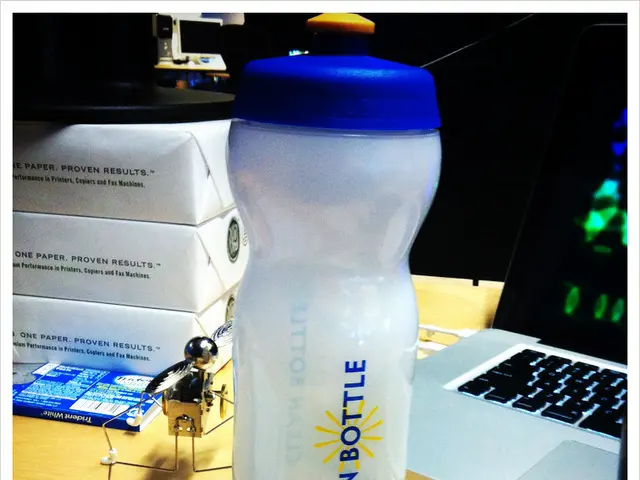Nanomaterial Breaks Efficiency Barrier, Converting Thermal Energy into Electricity More Efficiently Than Previous Standards
In a groundbreaking development, improvements in thermoelectric materials have rapidly escalated their effectiveness in converting heat into electricity, outpacing previous expectations. These advancements could revolutionize various aspects of our daily energy consumption, making processes more efficient and eco-friendly.
Record-setting Efficiencies
Recent research has delivered impressive results in thermoelectric efficiency:
- Scientists at Penn State achieved a conversion efficiency of 15% in a single-leg device, surpassing commercially available devices with efficiencies of 5-6%.
- Researchers at TU Wien developed a new material with a ZT value of 5 to 6, a significant leap over previous records of 2.5 to 2.8.
- Researchers in Korea and the US created a polycrystalline tin selenide material, boasting a heat-to-electricity conversion efficiency close to 20%.
- A tellurium-free module reached an efficiency of over 8% at a heat-source temperature below 550 K.
Key Novelties
A number of approaches have contributed to these advancements:
- High-entropy materials: Penn State scientists utilized high-entropy engineering to maintain high power factors and low thermal conductivity simultaneously.
- Innovative materials: TU Wien's breakthrough involved a thin layer of iron, vanadium, tungsten, and aluminum applied to a silicon crystal.
- Advanced fabrication techniques: Researchers minimized the presence of heat-conducting "skin" on polycrystalline tin selenide, significantly improving its performance.
- Disorder and nanostructuring: Introducing disorder at different scales in materials like lead telluride has proven effective in boosting thermoelectric efficiency.
Consequences for Everyday Life
These advancements could impact everyday life in a multitude of ways:
Energy Storage and Transportation
- Energy-efficient picnic coolers: Coolers that require no ice, only a small battery to keep drinks cool all day.
- Efficient food delivery: Meals delivered at the perfect temperature without energy-intensive cooling or heating systems in delivery vehicles.
- Improved electric vehicles: Electric cars capturing engine waste heat, extending their range without increasing battery size.
Energy Creation
- Autonomous power sources: Smartwatches or fitness trackers powered by body heat, eliminating the need for frequent recharging.
- Domestic energy generation: Water heaters or furnaces producing electricity from waste heat, lowering energy costs.
- Greener industries: Factories recovering a substantial portion of waste heat, potentially reducing energy costs and carbon emissions by up to 20%.
Daily Applications
- Energy-efficient refrigerators: Homes refrigerators becoming more energy-efficient and quieter without compressors.
- Smartphone cooling: Phones that never overheat, thanks to minute thermoelectric coolers maintaining processor temperatures.
- Climate control clothing: Jackets or vests providing comfort in any weather without heavy insulation.
Polycrystalline Tin Selenide Production
The polycrystalline tin selenide (SnSe) material with a record-breaking heat-to-electricity conversion efficiency of nearly 20% was produced using a specific synthesis technique[3]. Here's how it was fabricated:
- The researchers used a two-step process to create the material[4]:
a. First, they purified the tin starting reagent.b. Then, they purified the synthesized SnSe samples.
- A critical innovation was eliminating the heat-conducting "skin" on the material's surface[3]:
a. They reduced the tin starting material using hydrogen and argon.b. The tin selenide compound was also reduced using the same gases.c. The ensemble was then annealed at high temperatures.
- Removing this oxide layer was essential because it was 150 times more thermally conductive than tin selenide itself[3].
- By eliminating this heat-conducting layer, the researchers achieved an ultralow lattice thermal conductivity of approximately 0.07 W m^-1 K^-1 at 783 K, which is even lower than in single crystals[4].
This meticulous purification and oxide removal process resulted in a polycrystalline SnSe material with a thermoelectric figure of merit (ZT) of 3.1 at 783 K, leading to the reported heat-to-electricity conversion efficiency of nearly 20%[3][4].
Future Outlook
The focus remains on developing both p-type and n-type materials with complementary properties, further increasing efficiency, and exploring new material combinations. These advancements bring us closer to a future where waste heat is effectively harnessed for sustainable energy production.
While these advancements show promise, widespread implementation relies on additional improvements in efficiency and cost-effectiveness. Current thermoelectric systems convert about 15-20% of waste heat into usable electricity, a significant improvement from the 5-7% efficiency of older systems. As research continues, we might witness even higher efficiencies, and more practical applications in the coming years.
The potential influence of these advancements on waste heat recovery, space exploration, and sustainable energy production is significant. As efficiencies approach 20%, thermoelectric technology becomes competitive with other renewable energy sources like solar. Furthermore, some new materials are less toxic and more affordable than traditional thermoelectrics, potentially expanding their uses and making them relevant to the average consumer.
In summary, rapid advancements in thermoelectric technology offer an exciting glimpse into a future where energy is utilized more efficiently and sustainably, benefiting both individuals and the planet at large.
- The breakthrough in producing a polycrystalline tin selenide material with an exceptional heat-to-electricity conversion efficiency, nearly 20%, could have notable implications for the health-and-wellness sector, as it might lead to the development of smartwatches or fitness-and-exercise trackers that are powered solely by body heat, contributing to a more eco-friendly lifestyle.
- As advancements in thermoelectric technology continue to elevate, with greater efficiency and eco-friendliness, we could foresee a future where household appliances such as energy-efficient refrigerators, powered by waste heat, not only save on energy costs but also contribute to the broader goal of health-and-wellness and fitness-and-exercise by reducing potential toxins and emissions generated by traditional appliances, making them more conducive to a safer and healthier living environment.






